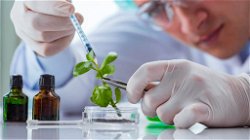Fertilizers for Agricultural Purposes: Their Benefits and Drawbacks
Poonam Junjunwala
. 4 min read
The production of crops in today's modern industrial agriculture is largely dependent on the use of fertilizers. As more people become aware of the advantages of organic farming and search for cultivation practices that are compatible with the natural environment, the discussion regarding the use of these fertilizers has become an urgent issue in today's society.

The benefits of utilizing fertilizers in Agricultural Settings
Foster the development of plants:
In general, chemical fertilizers are comprised of the primary plant nutrients of nitrogen, potassium, and phosphorous. These elements are present in chemical fertilizers in specific proportions that are calibrated to meet the requirements for crop growth that are unique to individual plants, such as corn or tomatoes. Because the plant's fundamental dietary needs are being fulfilled, it is possible for crops to be grown even in soils that have been depleted of their nutrient content. These nutrients come from fertilizers.
Offers a reliable and productive source of the nutrients the body needs:
Fertilizers that are manufactured have a known proportion of phosphorous, potassium, and nitrogen in their composition. These nutrients are able to dissolve and travel quickly to the cells of a plant, which is exactly where they are required. Due to the uniformity of the nutrients found in fertilizers, production on a commercial scale can be carried out effectively.
Rich in various nutrients:
Organic fertilizers are made through natural processes rather than artificial ones; however, their production is slower, and they take more time to get ready, but they are healthier for the plants. Chemical fertilizers, on the other hand, are widely used because they can quickly stimulate plant growth. Also provides the plant with all of the nutrients it requires without being harmful to either humans or the environment.
Therefore, fertilizers, in whatever form they may take, are the primary component of plant food that enables healthy plant growth.
Accessible in a Simple Manner:
As a result of the fact that fertilizers are excellent for promoting rapid growth in plants and are the most beneficial to agricultural production, their demand is growing. However, numerous factories are working hard to keep up with this demand. As a consequence, it is now possible to acquire all forms of fertilizer easily from the market.
The Importance of Fertilizers for Plant Growth and Metabolism
Fertilizers are essentially food for plants, and as such, they encourage the plants metabolism and growth. It is only possible when a correct metabolic activity is being carried out at the same time. The ease with which plants can digest fertilizers contributes to an increase in the metabolic rate of plants, which in turn promotes increased plant growth.
Cons of employing the use of fertilizers
Monitoring the Amount of Fertilizer in the Soil Since too much fertilizer can be harmful to plants and the soil in which they grow, the amount of fertilizer in the soil needs to be carefully monitored in order to ensure that it contains the appropriate amount at all times. This can be accomplished by having a soil test conducted in a soil lab or by using a device that is hand held.
Costs Incurred by Fertilizer
Few individuals are capable of producing their own fertilizer, despite the fact that there are many different kinds available. Even though making organic fertilizer through the process of composting requires some time and space, it does not provide an immediate solution to a nutrient deficiency in a lawn or garden.
Fertilizers' Potential to Cause Toxicity
Even organic fertilizers, if ingested in sufficient quantities, can produce toxic effects. There is a warning label on chemical fertilizers because many of them are harmful to humans and animals if they are ingested or if there is prolonged contact with the skin.
Different kinds of fertilizers for Plants Growth and Metabolism
Nitrogen: It is widely regarded as the single most crucial nutrient for plant growth; in fact, plants take in more nitrogen than any other element. Nitrogen is a component that must be present in order for plants to develop in a healthy manner and for those plants to be edible after they have been harvested.
Phosphorus: the second of the "Big 3," is connected to a plant's capacity to use and store energy, including the process of photosynthesis, and is therefore considered an essential nutrient. In addition to this, plants rely on it to help them grow and develop normally.
Phosphate rock: It is the source of the phosphorus that is found in commercial fertilizers. Phosphorus-deficient corn is depicted in the image that can be found below.
Potassium: The third essential nutrient that can be found in commercial fertilizers is potassium. It has a significant impact on improving crop yields and overall quality, as well as enhancing plants' natural resistance to disease, which in turn helps plants become healthier. Potassium protects the plant from the effects of cold and dry weather by fortifying the plant's root system and preventing wilting. Organic fertilizers also provide this protection.
Organic fertilizers: These are mineral sources that are naturally available and contain only a moderate amount of plant nutrients that are essential for plant growth. They have the ability to reduce the negative effects that are caused by synthetic fertilizers. They lessen the frequency with which it is necessary to apply synthetic fertilizers in order to keep the fertility of the soil intact.
Understanding Fertilizer Ratios: The Importance of Nitrogen, Phosphorus, and Potassium in Plant Growth
A 10-10-10 NPK ratio would make an excellent all-purpose fertilizer (nitrogen, phosphorus, and potassium). The majority of plant species and soil compositions will benefit from the application of this kind of fertilizer. Because sandy soils do not retain nutrients as well as clay-based soils do and often require more nitrogen than clay-based soils do, you may want to use a fertilizer that has more phosphorus in addition to a higher NPK value such as 15-15-15. This is because sandy soils do not hold nutrients as well as clay-based soils do.
Using Slow-Release Fertilizers for Flower and Fruit Tree Growth
Using slow-release fertilizers for flower and fruit tree growth is a common practice in gardening and horticulture. These types of fertilizers, such as Osmocote, release their nutrients over a period of time, typically several months, rather than all at once. This allows for a steady supply of nutrients for plants, promoting steady and consistent growth. Slow-release fertilizers are particularly useful when used in conjunction with organic mulches such as straw or pine needles, which provide additional nutrients and help retain moisture around the base of the plant. This method is particularly useful for growing flowers and fruit trees.
More Stories from
Biotechnology and the Future of Medicine: Advancements and Ethical Concerns
This article explores precision medicine's personalized treatments, the promise and ethical challenges of gene editing, the potential of artificial intelligence in healthcare, and the future of organ transplantation.
The Importance of the "Three Rs": Reduce, Reuse, Recycle
This article highlights the significance of the "Three Rs" - Reduce, Reuse, Recycle - in promoting sustainable practices and protecting the environment.
Unveiling India's Volcanic Secrets: A Geological Overview
Explore India's unique volcanic history and the enduring forces of nature that continue to captivate scientists and adventurers alike.
Zero-Waste Living: Practical Tips for Reducing Environmental Impact
Discover the power of zero-waste living as this article offers practical tips and actionable advice for reducing your environmental impact.
Eco-Friendly Practices: How Individuals and Businesses Can Make a Difference
Discover the Power of Eco-Friendly Practices: Learn how individuals and businesses can contribute to a greener world by adopting sustainable measures.










.png?width=40&aspect_ratio=1:1)


.png?width=40&aspect_ratio=1:1)